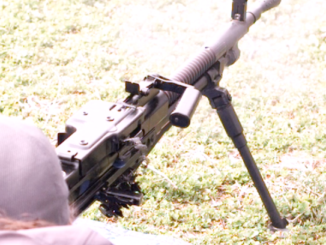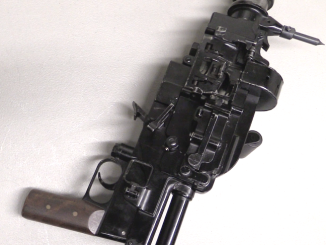The Madsen LMG is generally considered an extremely complex and confusing system – but is it really? Today we are taking one apart to see just how it actually works. Because in fact, it’s a very unusual system, but not really any more complicated than any other easy self-loading action.
Related Articles

General Purpose MGs
Danish Madsen-Saetter GPMG at the Range
The Madsen-Saetter is a general purpose machine gun that had the unfortunate luck to compete against the MG42/MG3 and FN MAG. It is a quite nice gun to shoot, but not quite up to the […]

Bolt Action Rifles
Madsen Lightweight Military Rifle
The M47 Madsen “Lightweight Military Rifle” was the last military bolt action rifle designed to be a primary infantry rifle, and it is a bit hard to see just who Madsen thought they could sell […]

Aircraft MGs
Beltfed Madsen LMG: When the Weird Gets Weirder
First produced in 1902, the Madsen was one of the first practical light machine guns, and it remained in production for nearly 5 decades. The Madsen system is a rather unusual recoil-operated mechanism with a […]

A good friend of our family was a Madsen gunner in the Danish Army. From what I understood from him, the Madsen was well-liked, and had a reputation for being robust and reliable (despite its “weird” mechanism).
And, among Danish soldiers at the time, “having a date with the virgin Madsen” meant going to the firing range 🙂
Thomas
According to W.H.B. Smith, the cam device shown on the patch was known to the Madsen factory people as the “switch plate”, which is probably a good name for it.
The use of the Madsen as an aircraft observer gun in WW1 makes good sense. Its ejection system made it very easy to fit with a shell collector bag to avoid ejected cases from being thrown out and possibly damaging part of the aircraft’s structure.
The one drawback to the Madsen as an infantry LMG is its lack of a quick-change barrel. This plus its box magazine feed system puts it in the category of a true machine rifle, as with the American BAR.
clear ether
eon
“(…)use of the Madsen as an aircraft observer gun in WW1 makes good sense(…)”
It was also relatively light, which was handy taking into account limited payload capacity of 1914 aeroplanes.
“(…)lack of a quick-change barrel(…)”
If you need to emit more bullet thats REKYLGEVÆR m/1924 can then use Madsen Machine Gun, Mode”. 1926, 7 mm, Water Cooled, see 1st image from top
https://www.bevfitchett.us/machine-gun-v1-repeating-weapons/the-machine-gun-fhh.html
“(…)true machine rifle(…)”
This English language advert https://www.forgottenweapons.com/wp-content/uploads/manuals/Madsen%20Machine%20Rifle%20Main%20Characteristics.pdf suggest that manufactured considered model Alfa and model Beta to be machine rifles, whilst model Eta and model Epsylon to be machine guns.
The Madsen LMG is an industrial tool. Like a lightbulb assembly tool, or a barbed wire assembly tool.
The kind of complete control it has over the cartridge (“the piece to be worked”), with one element (and sometimes two, see the lever-actuated recoil spring) performing one action (the rammer pushes the cartridge into the chamber, the tilting bolt locks it, the hammer/striker fires it, the tilting bolt unlocks it, the tilting extractor extracts it…), is typical of that kind of tools.
In that kind of tools, where there is a single machine in the factory to work a million pieces a week, simplification doesn’t matter.
That’s why it works. Because that kind of tools work.
The downside is the cost, and the work of who has to service it.
Was that done in order to be able to adopt wide array of cartridge types or this ability is side-effect of such design?
Two main reasons.
The field of self-loading firearm was still very new, so there wasn’t a clear pattern to follow. It’s like for the early semiauto pistols designs. The designers did what they were more used to, and they were more used to industrial tools designing.
The need to circumvent patents that were less than 20 years old, and so still valid.
Awesome piece of history, thank you Ian.
C&rsenals 1st video on the Madsen. Skip to time 51:15 to see the animation of how the gun works. https://www.youtube.com/watch?v=duOpp4Gr2Vg
https://store.steampowered.com/news/app/262410/view/2921103526305832139 suggest that Madsen machine gun is available for World of Guns, latter itself is free to play, but I do not know if it is possible to access said fire-arm in such manner.
While not a true quick change, it is pretty simple to remove the barrel+extension+bolt assembly and drop in another. I’d argue that’s actually a more elegant manual of arms since there’s no separable bolt, carrier, or recoil spring to lose.
I’m interested in hearing your thoughts on the Madsen machine gun — its design, historical usage, and characteristics. Developed in Denmark at the end of the 19th century, the Madsen machine gun became a key weapon, playing a significant role in wars. Its history underscores the importance of controlling the proliferation of firearms and the need for a sensible approach to regulating them. Recently, I also stumbled upon an intriguing analysis of gun control on the https://papersowl.com/examples/gun-control/ website, which highlights the importance of regulating access to firearms for public safety. Examining the historical role of firearms in wars and conflicts emphasizes the need for a balanced approach to public safety.
Cool post!